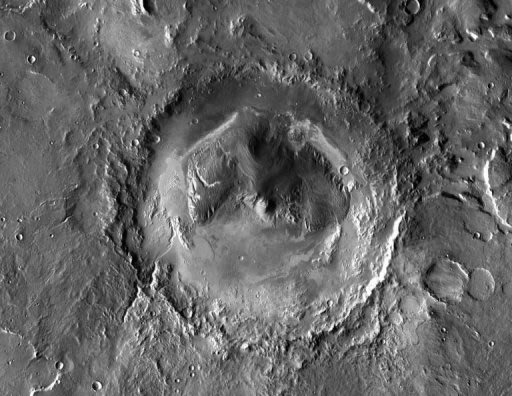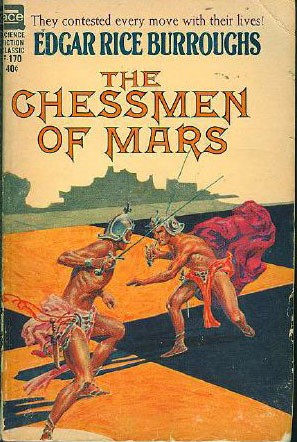The target.

This image obtained from NASA, shows Mars' Gale Crater. NASA announced the selection of Gale Crater as the landing site for the Mars Science Laboratory mission
Posted on 07/22/2011 1:15:12 PM PDT by NormsRevenge
The US space agency's unmanned Curiosity rover will explore a mountain on Mars that should read like "a great novel," revealing if signs of life ever existed on the red planet, NASA said Friday.
The landing site for the 2.5 billion dollar Mars Science Laboratory (MSL) was unveiled the day after the 30-year shuttle era ended with the return to Earth of Atlantis after its final mission to the International Space Station.
Clues sent home from Mars are important to NASA as it aims to build a spaceship capable of toting humans there by 2030, while private companies race to replace the shuttle with a capsule suitable for low-Earth orbit.
More than 150 scientists have spent years whittling down the landing site for Curiosity, the largest US rover ever, set to launch later this year and land in August 2012.
From an initial set of 30 potential spots, they finally decided on the Gale crater, which contains a five kilometer (three mile) high mountain, over its leading rival the Eberswalde crater, which is home to a dried-up river delta.
...
"This could be the tallest mountain in the solar system that we could actually climb with a rover," he said.
The mountain, tucked inside the 154 kilometer (96 mile) wide crater, is shaped like a broad mound so the six-wheeled rover can climb at least halfway up.
When Curiosity arrives over Mars, the car-sized craft will be lowered onto a flat part of the crater by tethers suspended from a rocket-powered sky crane, while a camera on the rover's base snaps high resolution images of the terrain beneath.
The vehicle, which uses a radioisotope power source for heat and electricity, will carry 17 cameras and 10 science instruments, as well as a potent laser beam, drill and robotic arm.
(Excerpt) Read more at news.yahoo.com ...
The target.

This image obtained from NASA, shows Mars' Gale Crater. NASA announced the selection of Gale Crater as the landing site for the Mars Science Laboratory mission
JPL/Nasa
PRESS RELEASE
07.22.2011
NASA’s Next Mars Rover to Land at Gale Crater
http://mars.jpl.nasa.gov/news/whatsnew/index.cfm?FuseAction=ShowNews&NewsID=1141
PASADENA, Calif. — NASA’s next Mars rover will land at the foot of a layered mountain inside the planet’s Gale Crater.
The car-sized Mars Science Laboratory, or Curiosity, is scheduled to launch late this year and land in August 2012. The target crater spans 96 miles (154 kilometers) in diameter and holds a mountain rising higher from the crater floor than Mount Rainier rises above Seattle. Gale is about the combined area of Connecticut and Rhode Island. Layering in the mound suggests it is the surviving remnant of an extensive sequence of deposits. The crater is named for Australian astronomer Walter F. Gale.
“Mars is firmly in our sights,” said NASA Administrator Charles Bolden. “Curiosity not only will return a wealth of important science data, but it will serve as a precursor mission for human exploration to the Red Planet.”
During a prime mission lasting one Martian year — nearly two Earth years — researchers will use the rover’s tools to study whether the landing region had favorable environmental conditions for supporting microbial life and for preserving clues about whether life ever existed.
“Scientists identified Gale as their top choice to pursue the ambitious goals of this new rover mission,” said Jim Green, director for the Planetary Science Division at NASA Headquarters in Washington. “The site offers a visually dramatic landscape and also great potential for significant science findings.”
In 2006, more than 100 scientists began to consider about 30 potential landing sites during worldwide workshops. Four candidates were selected in 2008. An abundance of targeted images enabled thorough analysis of the safety concerns and scientific attractions of each site. A team of senior NASA science officials then conducted a detailed review and unanimously agreed to move forward with the MSL Science Team’s recommendation. The team is comprised of a host of principal and co-investigators on the project.
Curiosity is about twice as long and more than five times as heavy as any previous Mars rover. Its 10 science instruments include two for ingesting and analyzing samples of powdered rock that the rover’s robotic arm collects. A radioisotope power source will provide heat and electric power to the rover. A rocket-powered sky crane suspending Curiosity on tethers will lower the rover directly to the Martian surface.
The portion of the crater where Curiosity will land has an alluvial fan likely formed by water-carried sediments. The layers at the base of the mountain contain clays and sulfates, both known to form in water.
“One fascination with Gale is that it’s a huge crater sitting in a very low-elevation position on Mars, and we all know that water runs downhill,” said John Grotzinger, the mission’s project scientist at the California Institute of Technology in Pasadena, Calif. “In terms of the total vertical profile exposed and the low elevation, Gale offers attractions similar to Mars’ famous Valles Marineris, the largest canyon in the solar system.”

This artist concept shows NASA's Mars Science Laboratory Curiosity rover, a mobile robot for investigating Mars' past or present ability to sustain microbial life. The US space agency's unmanned Curiosity rover will explore a mountain on Mars that should read like "a great novel," revealing if signs of life ever existed on the red planet, NASA said
Are they going to swap out that flag they left the last time???
Cool. I still want to get a closer look at the canyons too.
I’ve offered to go myself but NASA won’t let me.
—
The rover is not a “life-detection mission and we cannot look for fossils,” he added. “But we can look for organic carbon that may be observed there,” which would indicate some life once existed.
The announcement of Curiosity’s exact destination came 35 years after the first spacecraft, the Viking 1, landed on Mars in July 1976.
NASA’s solar-powered rovers, Spirit and Opportunity, landed in 2004 on what was to be a three-month mission.
Opportunity is still trucking along, but in May NASA finally gave up on Spirit, believed to have frozen to death during the harsh Martian winter.
—
These are the kinds of missions that NASA should undertake. Not endless encircling the earth.

I wanna see what’s in the holes that open into caves..
too bad ya can’t user your frequent flier miles to check ‘em out. lol
can’t wait.. should be some great sunset shots.
as always econuts will be protesting the launch of any nuclear-powered equipment, that’s the dessert. Blast-off!
We been launching stuff for years, some of it worked, some of it crashed..
http://mars.jpl.nasa.gov/programmissions/missions/
NASA has been politicized. This probe to Mars is just trying to divert attention away from the fact that the US manned spaceflight program is dead for at least 30 years.
Wait til one of these guys pops out of the sand..................

Humans landing on Mars will be inspirational. It will little to exploration, though.
Absolutely. Obama and his democrats should be very proud.

NASA's next Mars rover will land at the foot of a layered mountain inside the planet's Gale Crater.

NASA's next Mars rover has completed the journey from its California birthplace to Florida in preparation for launch this fall.
Disclaimer: Opinions posted on Free Republic are those of the individual posters and do not necessarily represent the opinion of Free Republic or its management. All materials posted herein are protected by copyright law and the exemption for fair use of copyrighted works.